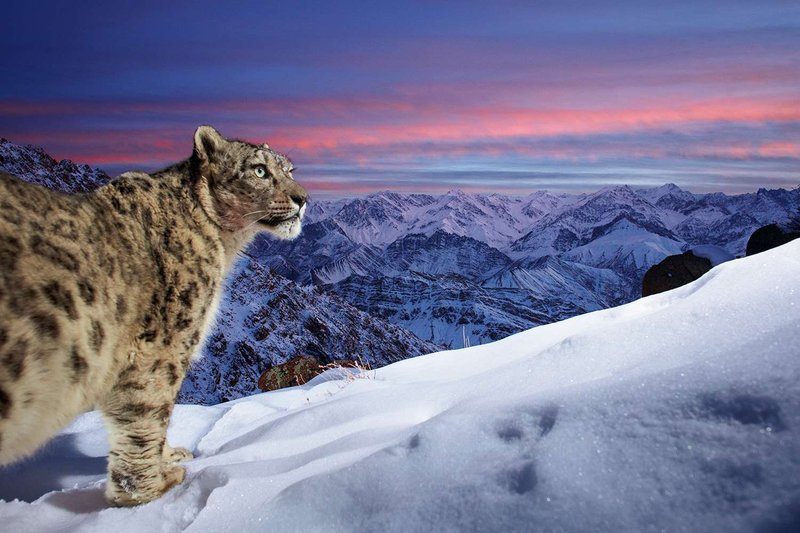
Encountering a snow leopard is a unique experience. These animals are masters of their environment, blending seamlessly into their cold surroundings. They are known for their incredible agility, keen senses, and solitary nature. But while they’re often seen as mysterious and majestic, it’s essential to understand their behavior and how to act if you find yourself in their presence. Think of this as a guide to navigating a captivating yet potentially risky moment in nature.
Understanding Snow Leopards
Snow leopards are more than just pretty faces in the mountains. They play a crucial role in their ecosystem, helping to maintain the balance by being top predators. Understanding their characteristics can help you react appropriately during an encounter. Here are a few things to know:
- Habitat: Snow leopards typically inhabit rugged, mountainous regions of Central and South Asia, often at elevations of 9,800 to 13,000 feet. Their thick fur and long tails help them navigate steep, snowy terrains.
- Behavior: They are mostly solitary animals, coming together only during mating season or when a mother is raising her cubs. This solitary nature can make spotting them even more special.
- Diet: These big cats primarily hunt ungulates such as blue sheep, ibex, and other small mammals. Their hunting style involves stealth and bursts of speed, allowing them to ambush prey.
Understanding these aspects of snow leopards can help you appreciate their beauty while keeping safety in mind.
Stay Calm and Observe
If you ever spot a snow leopard, the first thing to remember is to stay calm. Panicking won’t help the situation. Instead, take a moment to savor the experience. Here’s what to do next:
- Keep your distance: Snow leopards are wild animals, and it’s crucial to respect their space. Try to maintain a safe distance; ideally, stay at least 100 yards away. This keeps you safe and allows you to appreciate the animal without disturbing it.
- Observe quietly: instead of rushing to take pictures or making loud noises, take a deep breath and enjoy the moment. Watching their behavior can be fascinating, whether they’re lounging in the sun or playing in the snow.
- Be still: Moving suddenly might frighten the snow leopard. Remain still, staying as undetectable as possible. They have excellent vision and can see movement from afar.
Taking a breath and observing lets you enjoy this rare encounter while prioritizing your safety.
Knowing When to Retreat
Sometimes, despite your best efforts, the snow leopard may feel threatened or curious about your presence. Recognizing the signs that you should back away is critical. Watch for these behaviors:
- Ear and tail movements: If the snow leopard flattens its ears or flicks its tail, it may be agitated. These signs indicate it’s time to slowly retreat.
- Body language: If it starts to crouch or move toward you, don’t stay put. This behavior can signal curiosity or aggression. Make your exit carefully and quietly.
- Vocalizations: Snow leopards can growl or hiss when threatened. If you hear these sounds, consider it a clear sign to back off.
Being aware of their body language is crucial for both your safety and the well-being of the leopard.
Use Your Gear Wisely
In the wild, having the right gear can make a significant difference in both safety and enjoyment. Here’s what to consider when encountering a snow leopard:
- Binoculars or a good camera with a zoom lens can allow you to observe from a distance without intruding. You don’t want to get too close, but you still want to capture the moment.
- Wildlife guidebooks can help you identify various animal behaviors, including those of snow leopards. This knowledge can enhance your experience and keep you informed.
- Emergency gear: Always carry a first-aid kit and a whistle when exploring remote areas. In case of an emergency, these tools can be invaluable.
Having the right equipment lets you appreciate this rare encounter while ensuring you stay safe.
Respect Local Regulations
When exploring the habitat of snow leopards, always respect local wildlife regulations. These rules are in place to protect both you and the animals. Here are some essential points to keep in mind:
- Follow guidelines: Many areas have specific guidelines or restrictions on how close you can get to wildlife. Familiarize yourself with these before heading out.
- Avoid feeding: Never feed wild animals, including snow leopards. Feeding them can disrupt their natural hunting behavior and lead to dangerous situations.
- Report sightings: If you spot a snow leopard, consider reporting it to local wildlife authorities. This information can help them understand and protect these magnificent creatures better.
Respecting these regulations not only keeps you safe but also helps conserve the delicate ecosystems where snow leopards live.
Share Your Experience
After your encounter, sharing your experience can help raise awareness about snow leopards and the importance of wildlife conservation. Here’s how you can make your voice heard:
- Social media: Post photos and share your story online, but be sure to emphasize the need for conservation and respect for wildlife.
- Join conservation groups: Many organizations focus on protecting snow leopards and their habitats. Getting involved can help contribute to their survival.
- Educate others: Talk to friends and family about your experience. Sharing what you learned can inspire others to appreciate and protect wildlife.
By sharing your experience, you help others understand the beauty and importance of snow leopards, fostering a greater appreciation for wildlife.
Encountering a snow leopard in the wild can be awe-inspiring, but it comes with responsibilities. By understanding their behavior, preparing wisely, and respecting the environment, you can enjoy this incredible experience while ensuring both your safety and that of the snow leopard. Each moment spent in nature teaches us something valuable, and embracing these journeys helps us appreciate the wild world around us. So, the next time you find yourself in the snow leopard’s terrain, remember these tips, stay calm, and cherish this extraordinary connection to nature.

